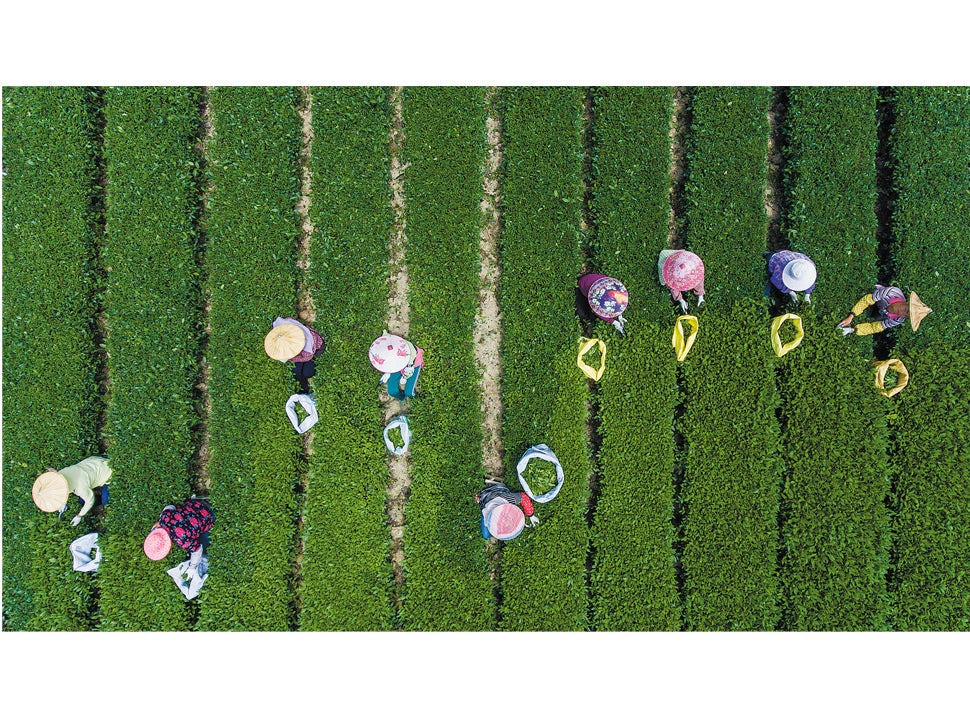Tea gardens increase carbon sink capacity
THE ARTICLES ON THESE PAGES ARE PRODUCED BY CHINA DAILY, WHICH TAKES SOLE RESPONSIBILITY FOR THE CONTENTS

Agricultural activities contribute about 30 per cent of the total global greenhouse gas (GHG) emissions, mainly due to the use of chemical fertilisers, pesticides and animal wastes, but agricultural ecosystems can also offset 80 per cent of the emissions, according to data from the United Nations Food and Agriculture Organisation.
The carbon sequestration potential of farmlands in China has been studied more closely in recent years, with the Ministry of Agriculture and Rural Affairs releasing an action plan this year, 2022, to reduce GHG emissions from farmlands and rural areas.
The ministry’s action plan is aimed at boosting the recycling of straw and stubs, increasing the use of organic fertilisers, and intensifying the development of high-standard farmland to strengthen the carbon sequestration and carbon retention capacity of tea plantations and fruit orchards.
Tea gardens in South China’s Fujian province are seen as a sally port for reducing agricultural GHG emissions thanks to their high plant coverage.
A major tea-producing county with 154 square miles of tea plantations in south-eastern Fujian, Anxi has been promoting techniques to reduce carbon emissions, among other things, by growing high-yield varieties, closer planting of tea plants to boost photosynthesis, and using smart pest-prevention methods to reduce the use of chemical pesticides.
Li Zhipeng, a researcher at the provincial academy of agricultural sciences, said that despite being one of the biggest sources of GHG emissions, farmlands also have huge carbon sink capacity. Carbon sink refers to anything that absorbs more carbon from the atmosphere than it releases, such as plants.
For example, the expansive green cover and large plant canopies in tea plantations create favourable conditions for photosynthesis. And the fact that a lot of branches and leaves are pruned every year in tea plantations helps develop carbon pools on the soil surface, Li told Fujian Daily.
To determine the carbon sink capacity of tea plantations, accurate GHG or carbon emissions calculations are needed.
Accordingly, a meteorological observation system has been introduced in a smart farm in Anxi. It records weather information such as the temperature, and precipitation and radiation levels that help determine the carbon sink capacity.
Wang Miaomiao at the academy’s Institute of Digital Agriculture said tea plantations sequestrate carbon in two ways. They absorb carbon dioxide (CO2) through photosynthesis and their soil soaks up organic carbon.
Researchers used the data obtained from the new meteorological observation system to deduce the carbon flux of tea plants through the ecological process, and estimate the soil’s organic carbon storage capacity through laboratory analysis.
Huang Wenbiao, an official in the provincial agricultural and rural affairs department, said that although it could take years to calculate the carbon sink capacity in tea plantations, the experience and knowledge gained from carbon sequestration in forests can be applied to the agricultural sector, especially to set trading rules and develop related financial products.
Carbon sink trading can be introduced first to the agricultural sector, especially in plantations and aquaculture, to achieve carbon neutrality, he said.
Animal husbandry accounts for a large percentage of global GHG emissions. Large volumes of methane, a non-CO2 and relatively toxic greenhouse gas, are emitted by ruminants and during the waste fermentation of livestock and poultry. In contrast, fruit trees and tea plants have strong carbon sequestration capability, Huang said.
To reduce GHG emissions and increase farmlands’ carbon sink capacity, the authorities launched the first agricultural carbon sink trading platform in Xiamen, Fujian, on May 5, 2022, to provide services for developing, measuring and trading carbon sink. The first batch of two-year “carbon tickets” for increasing carbon sink capacity was issued on the same day in two villages with large areas under tea plantation.
Carbon tickets are issued by a third-party agency to monitor and evaluate crops with clear ownership, and submit reports that will help calculate agricultural carbon sinks within a certain range.
Yang Jie in Fuzhou contributed to this story.
